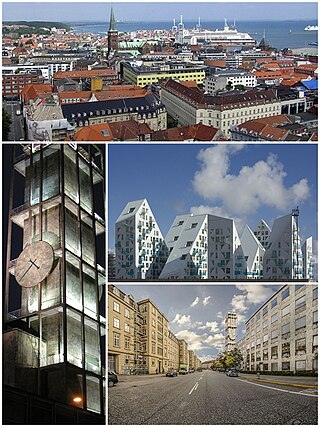
Aarhus is the second-largest city in Denmark and the seat of Aarhus Municipality. It is located on the eastern shore of Jutland in the Kattegat sea and approximately 187 kilometres (116 mi) northwest of Copenhagen.

Hedeby was an important Danish Viking Age trading settlement near the southern end of the Jutland Peninsula, now in the Schleswig-Flensburg district of Schleswig-Holstein, Germany. Around 965, chronicler Abraham ben Jacob visited Hedeby and described it as, "a very large city at the very end of the world's ocean."

Middelfart is a town in central Denmark, with a population of 16,546 as of January 2023. The town is the municipal seat of Middelfart Municipality on the island of Funen.
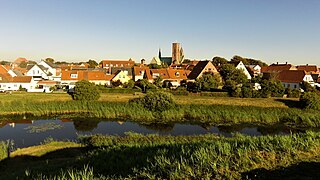
Ribe is a town in south-west Jutland, Denmark, with a population of 8,365 (2023). It is the seat of the Diocese of Ribe covering southwestern Jutland. Until 1 January 2007, Ribe was the seat of both a surrounding municipality and county. It is now part of the enlarged Esbjerg Municipality in the Region of Southern Denmark. It is the oldest town in Denmark.

The Kongeå is a watercourse in Southern Jutland in Jutland, Denmark. It rises southeast of Vejen and Vamdrup and after about 50 kilometres (31 mi) it flows through a sluice to tidal mudflats and sandbanks north of Ribe, and eventually into the North Sea. The eastern section is little more than a stream, while the western section is navigable by boat as far as the sluice. The Kongeå, however, passes no port or market town of any significance, and small boats use the Ribe Å.

Moesgaard Museum (MOMU) is a Danish regional museum dedicated to archaeology and ethnography. It is located in Beder, a suburb of Aarhus, Denmark.

Struer is the main town of the kommune of Struer, Region Midtjylland, Denmark with a population of 10,112.

Esbjerg is a seaport city and seat of Esbjerg Municipality on the west coast of the Jutland peninsula in southwest Denmark. By road, it is 71 kilometres (44 mi) west of Kolding and 164 kilometres (102 mi) southwest of Aarhus. With an urban population of 71,921 it is the fifth-largest city in Denmark, and the largest in West Jutland.

Herning is a Danish town in the Central Denmark Region of the Jutland peninsula. It is the main town and the administrative seat of Herning Municipality. Herning has a population of 51,193 including the suburbs of Tjørring, Snejbjerg, Lind, Birk, Hammerum, and Gjellerup, making Herning the 11th most populous urban area in Denmark.
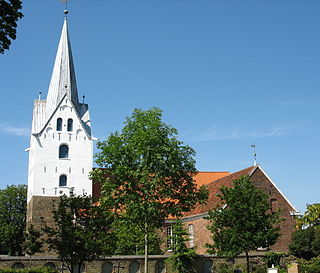
Varde is a Danish city in southwestern Jutland and is the primary city in the municipality of Varde, in Region of Southern Denmark. In 2015 municipality changed its motto to "We in nature" to emphasize its rural atmosphere. The town has an old market environment and is located by Varde stream/river and is a short distance away from the beaches by the North Sea. These features make it a tourist destination. The age of Varde is not known precisely, but it is mentioned in written sources from 1107 A.D. and is therefore thought have been founded sometime in the early Middle Ages.

Skjern is a railway town just north of the Skjern river in western Jutland, Denmark with a population of 7,840. The town was the seat of the former Skjern Municipality, though since 2007 it has been the joint administrative seat of Ringkøbing-Skjern Municipality.
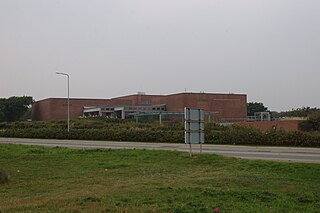
The Fisheries and Maritime Museum is a privately owned museum in Esbjerg, Denmark. Opened to the public in 1968, it consists of a saltwater aquarium for native species and a "sealarium" as well as indoor and outdoor exhibitions on Danish fisheries and shipping.
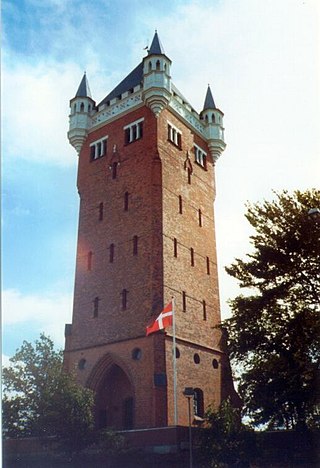
Esbjerg Water Tower is an iconic water tower in Esbjerg in southwest Jutland, Denmark. Completed in 1897, it was designed by Christian Hjerrild Clausen who had been inspired by Nuremberg's Nassauer Haus. It stands on a Bronze Age burial mound at the top of a cliff overlooking the harbour. As a result, it has become the landmark of Esbjerg.

The Esbjerg Art Museum is an independently owned art museum in Esbjerg in southwest Jutland, Denmark. Founded in 1910, in 1962 it moved into a new building in the City Park designed by Jytte og Ove Tapdrup. Since 1997, the museum has formed part of a complex which also contains the Esbjerg Performing Arts Centre.
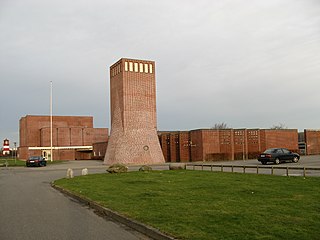
Sædding is a district of Esbjerg in southwest Jutland, Denmark, some 5 km (3.1 mi) northwest of the centre and 5 km (3.1 mi) southeast of Hjerting.

The Port of Esbjerg on the southwest coast of Jutland is a competitor to Aarhus and Hamburg for freight. Built by the State in 1868, it was once Denmark's principal fishing harbour but today has become Europe's leading port for shipping offshore wind turbines.

The Lightship Museum in the harbour of Esbjerg in southern Denmark consists of a private museum open to the public on board the Horns Rev lightship. Dating from 1912, the Horns Rev, also known as Motorfyrskibet Nr. I, is the world's oldest and best preserved motor lightship. It houses a highly regarded exhibition of life and work on board.

The Danish National Exhibition of 1909 or The National Exhibition in Aarhus 1909 was an industry, crafts and culture exhibition held in Aarhus, Denmark in 1909 from 18 May to 3 October. The exhibition displayed some 1850 individual works by architects, artists, craftsmen and businesses and attracted 650.000 visitors. The project was a large undertaking for the city with long-lasting effects on cultural institutions and short-term economic problems. The exhibition fairgrounds was named The white City based on the architectural expression chosen by the leading architect Anton Rosen.

Tirpitz Museum, also called Blåvand Bunker Museum, is a museum in Blåvand, on the coast of Jutland. It is built in an old bunker from which it got its name, and features exhibitions on the Atlantic Wall, the west coast of Denmark, and an amber collection.

Bramming is a railway town in Esbjerg Municipality, Region of Southern Denmark in Denmark. It is located at the Lunderskov-Esbjerg railway line and has a population of 7,171.




















